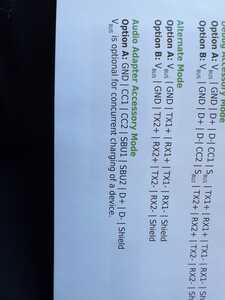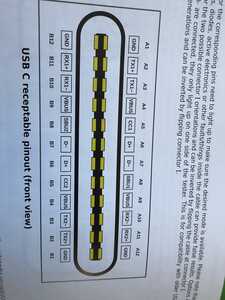Hey guys. This is a power circuit for a dev board I am working on.
Most of this was taken off of other designs and I have been trying to learn how these things work. VBUS in the +5V supply from the usb-c connector and VBAT is the voltage from a lipo battery. The top is a siimple charging circuit and the botton circuit selects between VBUS and VBAT and then sends it to a voltage regulator to create +3.3V.
My question is this: Suppose I wanted to SUPPLY +3.3V to the usb-c (VBUS) when operating on battery. Is there an easy way to do this? My concern is then you have VBUS = 3.3V and for Q1 V(gs)th is about -0.7V, then that wouldn't work once the battery got below about +4V.
Any suggestions are appreciated.
Fish
Hi @fishbone,
Sorry fish, I admit to being wary of advising about circuits that include charging any type of lithium battery, knowing that lithium based batteries can become dangerous, so that this comment in no way endorses that part of your circuit.
--------
But in this case, I don't understand your question either, which may not involve the charging phase.
Surely VBUS expects to either be fed 5V, from a USB source, or have no feed, in which case it will be at 0V. The TP4054 CHRG is on open drain output with a weak pull down (according to the data sheet), so it cannot increase the voltage on VBUs either.
So, when you say:
Suppose I wanted to SUPPLY +3.3V to the usb-c (VBUS) when operating on battery. Is there an easy way to do this?
- How does VBUS acquire a 3.3V supply? It is an input, not an output.
- Why would you want VBUS to be at 3.3V, as it is too low for LDO1 to produce 3.3V for whatever circuit it is powering.
In addition, whilst LDO1 is claimed to have a small dropout voltage at low currents, its 'specification' recommendation is for 4.3V input for 3.3V output. Depending upon load current draw, I would be concerned that the output voltage from a single lithium cell was rather low. This feels like a 'works on a good day' design choice, but I accept if your current draw is small, you may have a lot of good days.
NB if you use the TP4054, with current limit set to 0.5A, which I think is what you have specified, make sure it doesn't overheat, especially when the battery voltage is low, it will need to lose a lot of heat for a small device!
Best wishes and stay safe, Dave
Hey @davee. Thanks for the reply!
I probably ask some dumb questions - but I am trying to learn. I'll explain what I am trying to do. My application is a pcb that has an esp32-S3 mcu. The usb-c port is for charging the battery as well as uploading data to the esp32. The pcb will also have an RDA5807M FM receiver. I have an idea/plan to send the output to a usb headset (I know the RDA5807 can output audio to a 3.5mm connector but I REALLLLLY want to use the usb-c). To offload some of the real estate from the pcb, I am toying with the idea of including the DAC/amp in a usb-c to 3.5mm "dongle" (I know I can output analog from the RDA5807 - but let's just say the design has a requirement that the only output is the usb-c). So if I have a dongle with DAC, I need to power it from +3.3V
I glossed over some details, but that is the gist
Fish
Hi fish @fishbone,
Thanks for your reply. I guessed you might be wanting to power an ESP32 of some type, which implies WiFi (or BlueTooth) might be in use, and which has a 'reputation' (deserved or not) for high current peak requirements when the wireless capability is exercised. This is partly why I was concerned about the voltage drop across LDO1, when the power source is a single lithium cell. I am not saying it will give trouble, merely that it looks like you are running it inside the margins that are recommended to give a reliable operation.
I confess I have never heard of the FM radio you mention before ... It is several decades since I last considered FM tuner design, and a quick Google search showed how out of touch I am! I recommend you prototype that part of the circuit, before committing to PCB design, if you haven't already done so. Consider filtering the power to reduce the chance of digital noise from the ESP32 affecting it.
I am not clear how adding a DAC, external to the RDA5807, would have as a data source, since the RDA chip does not appear to output the digital audio data stream. (Unless, perhaps, the ESP32 is providing digital audio data from another source.) Plus, how that involves the USB-C connection is unclear. (I can see you may wish to add an audio amplifier to drive loudspeakers, etc.)
At present, I don't think I can add much more, as my previous comments, questions and confusions remain much the same.
Best wishes, Dave
@fishbone I am still not 100% clear what you are doing at a low level, BUT I recently got a cable tester and USB-C power meter (both pricey) in order to sort all the fake cables. It was triggered by a robust discussion on USB-C PD etc.
Anyway, I think I noticed somewhere that there are specific pins on the USB-C cable. I am enclosing some screen grabs that show that info for what it is.
You will need some sort of way to test that the USB-C cable you choose to use has those pins actually wired, many/most inexpensive USB-C cables do NOT.
Let me know if you want me to post again the testers I am referring to.
First computer 1959. Retired from my own computer company 2004.
Hardware - Expert in 1401, and 360, fairly knowledge in PC plus numerous MPU's and MCU's
Major Languages - Machine language, 360 Macro Assembler, Intel Assembler, PL/I and PL1, Pascal, Basic, C plus numerous job control and scripting languages.
Sure you can learn to be a programmer, it will take the same amount of time for me to learn to be a Doctor.


